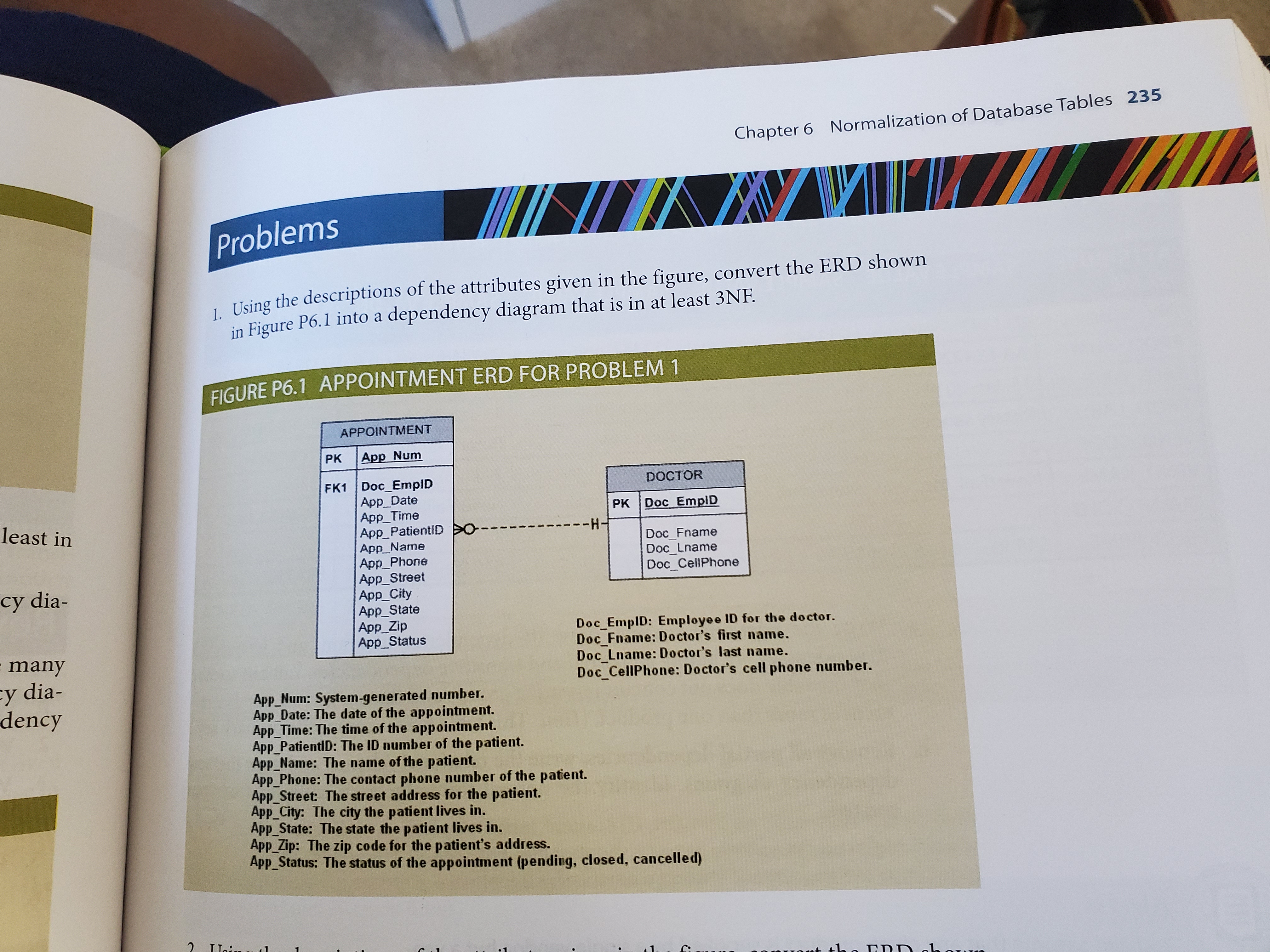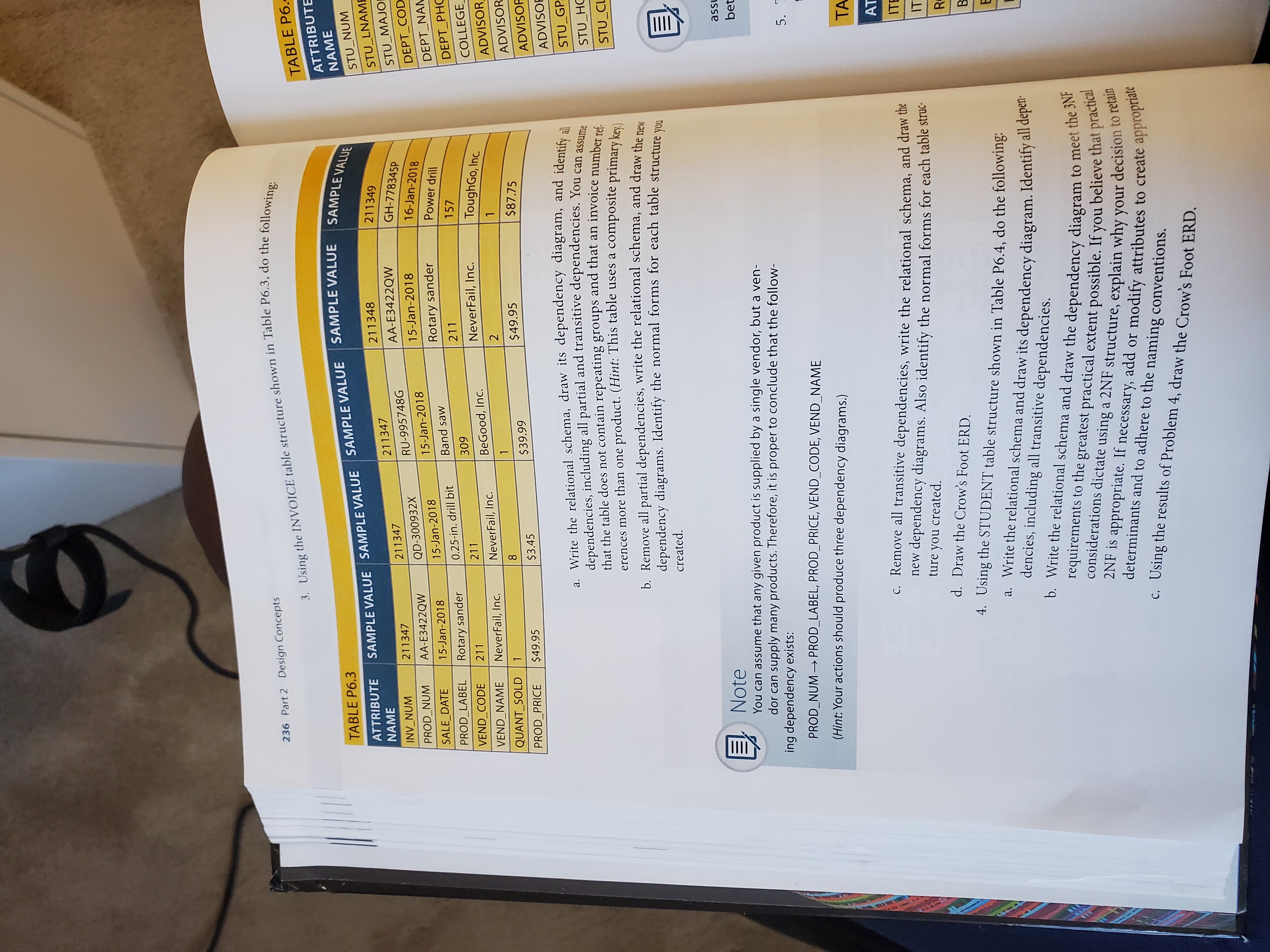
Database System Concepts
7th Edition
ISBN: 9780078022159
Author: Abraham Silberschatz Professor, Henry F. Korth, S. Sudarshan
Publisher: McGraw-Hill Education
expand_more
expand_more
format_list_bulleted
Concept explainers
Question
Problems 1 and 3 on pages 234 - 236 of the course textbook.
- You must use Draw.IO or MS Visio to complete this case study.Create an ER diagram
- Explain all normalization issues that exist in the ER Diagram.
- I want the ER Diagram before normalization and after normalization.
- Explain all normalization problems that you corrected between the first and second ER diagram.
- Normalize the data in the ER Diagram to 3NF See the video for a demonstration on how to do this: https://www.youtube.com/watch?v=Nq91b4TQ29Q
- Create a dependency diagram using the information from your ER diagram. See the video for a demonstration on how to do this: https://www.youtube.com/watch?v=wFOJnRxqrp8
- You must label all determinants and dependencies.
- Note: You must convert your DrawIO files to .jpg, gif or bmp images before you upload the assignment to Canvas. Copy and paste all diagrams into an MS Word document. Please make sure that you enlarge all diagrams so they can be easily read in Canvas preview. This will account for 20% of the lab grade.

Transcribed Image Text:Chapter 6 Normalization of Database Tables 235
Problems
1 Using the descriptions of the attributes given in the figure, convert the ERD shown
in Figure P6.1 into a dependency diagram that is in at least 3NF.
FIGURE P6.1 APPOINTMENT ERD FOR PROBLEM 1
APPOINTMENT
PK
App Num
FK1 Doc EmpID
App_Date
App Time
App_PatientID
App_Name
App Phone
App Street
App_City
App_State
App_Zip
App_Status
DOCTOR
least in
PK Doc EmplD
Doc Fname
Doc Lname
Doc CellPhone
cy dia-
Doc EmpID: Employee ID for the doctor.
Doc Fname: Doctor's first name.
Doc Lname: Doctor's last name.
Doc CellPhone: Doctor's cell phone number.
many
cy dia-
dency
App_Num: System-generated number.
App Date: The date of the appointment.
App_Time: The time of the appointment.
App PatientID: The ID number of the patient.
App_Name: The name of the patient.
App_Phone: The contact phone number of the patient.
App_Street: The street address for the patient.
App_City: The city the patient lives in.
App_State: The state the patient lives in.
App_Zip: The zip code for the patient's address.
App_Status: The status of the appointment (pending, closed, cancelled)

Transcribed Image Text:236 Part 2 Design Concepts
3. Using the INVOICE table structure shown in Table P6.3, do the following:
TABLE P6.-
ATTRIBUTE
SAMPLE VALUE
SAMPLE VALUE
TABLE P6.3
NAME
ATTRIBUTE
SAMPLE VALUE SAMPLE VALUE SAMPLE VALUE
STU NUM
NAME
211348
211349
211347
STU LNAME
211347
GH-778345P
INV NUM
211347
AA-E3422QW
RU-995748G
STU MAJO
QD-300932X
15-Jan-2018
16-Jan-2018
PROD_NUM
AA-E3422QW
15-Jan-2018
DEPT_COD
SALE_DATE
15-Jan-2018
15-Jan-2018
Power drill
Rotary sander
DEPT_NAN
Band saw
PROD LABEL
Rotary sander
0.25-in. drill bit
211
157
DEPT PHC
309
VEND_CODE
211
211
ToughGo, Inc.
NeverFail, Inc.
COLLEGE
BeGood, Inc.
VEND_NAME
NeverFail, Inc.
NeverFail, Inc.
ADVISOR
QUANT_SOLD
8.
$39.99
$49.95
$87.75
ADVISOR
PROD_PRICE
$49.95
$3.45
ADVISOF
ADVISOF
a. Write the relational schema, draw its dependency diagram, and identify ai
dependencies, including all partial and transitive dependencies. You can assume
that the table does not contain repeating groups and that an invoice number rf
erences more than one product. (Hint: This table uses a composite primary ke
STU GP.
STU HC
STU_CL
b. Remove all partial dependencies, write the relational schema, and draw the ne.
dependency diagrams. Identify the normal forms for each table structure vo
created.
you
Note
assu
bet
You can assume that any given product is supplied by a single vendor, but a ven-
dor can supply many products. Therefore, it is proper to conclude that the follow-
ing dependency exists:
PROD_NUM → PROD_LABEL, PROD_PRICE, VEND_CODE, VEND_NAME
(Hint: Your actions should produce three dependency diagrams.)
TA
AT
c. Remove all transitive dependencies, write the relational schema, and draw the
new dependency diagrams. Also identify the normal forms for each table struc-
ture you created.
ITE
IT
d. Draw the Crow's Foot ERD.
RO
4. Using the STUDENT table structure shown in Table P6.4, do the following:
a. Write the relational schema and draw its dependency diagram. Identify an der
dencies, including all transitive dependencies.
b. Write the relational schema and draw the dependency diagram to meet the 3NF
2NF is appropriate. If necessary, add or modify attributes to create appropriate
determinants and to adhere to the naming conventions.
requirements to the greatest practical extent possible. If you believe that practical
considerations dictate using a 2NF structure, explain why your decision to retain
c. Using the results of Problem 4, draw the Crow's Foot ERD.
ШИ
5.
Expert Solution
This question has been solved!
Explore an expertly crafted, step-by-step solution for a thorough understanding of key concepts.
This is a popular solution
Trending nowThis is a popular solution!
Step by stepSolved in 6 steps with 4 images

Knowledge Booster
Learn more about
Need a deep-dive on the concept behind this application? Look no further. Learn more about this topic, computer-science and related others by exploring similar questions and additional content below.Similar questions
- I am learning ER diagrams learning one, many, one and only, zero or one, one or many, and zero or many for the cardinality rules to create databases with. Question: How can I make plans for a ProResume database and turn them into an ER diagram? Also, what ER diagram tools might you know of that are possibly free and nice to use with MySQL? This is the plan I have thus far; ENTITIES Employers: These will be the companies or organizations that are hiring. Attributes: Employer ID, Company Name, Location, Contact Information Customers: These will be the Job Applicants or Candidates. Attributes: Customer ID, Name, Contact Information, Education, Experience References: These will be the references from customers. Attributes: Reference ID, Name, Contact Information, Relationship to Customer Skills: Will be software and hardware skill of the customer. Attributes: Skill ID, Skill Name, Proficiency Level Employment Positions: These will be…arrow_forwardhow to map ERR model to relational modelarrow_forwardPlease provide a list and illustrative example for the three forms of binary relationships that are not covered in this book. Draw a regular E-R diagram as well as an IE Crow's Foot E-R diagram for each of the three cases studied here.arrow_forward
- Instructions: In this assignment, you will convert an Entity-Relationship diagram into a set of related tables. Given the following ERD, write the table definitions for the entities displayed below. You do not have to indicate data types nor “not null” constraints in this lab. Use the format TableName ( attribute, attribute…attribute). Designate primary keys with an underline and foreign keys with a broken underline. To illustrate, the Regions and Countries table definitions have been created for you below the diagram. Type your answers in this document and upload it to the appropriate Blackboard assignment link by Monday at 11:59 p.m. ET of this module/week. Note that you should read the “Table Conversions Explained” document in your Reading & Study folder. I created it to help you better understand how ERDs will ultimately be transformed into real tables. ERD for the Hourglass timekeeping databasearrow_forwardplease help me write a latex/overleaf code for a table to be used for a weight decision matrix similar to the one depicted in the following figure, I don't know how to merge the cells at the top for each design Design 1 D2 D3 D4 D5 D6 Criteria(C) Weight Rating(R) Weight Score(WS) R WS R WS R WS R WS R WS C1 C2 C3 Totalarrow_forwardPlease provide a list and illustrative example for the three forms of binary relationships that are not covered in this book. Draw a regular E-R diagram as well as an IE Crow's Foot E-R diagram for each of the three cases studied here.arrow_forward
- Topic: Database Design and Entity Relationship Diagrams Please convert the following diagram to Crow's Foot notation.arrow_forwardPLz help with the following: Translate your ER diagram into a relational schema in the form of SQL DDLs. Choose appropriate data types for each attribute and include primary key and foreign key constraints, Check and Not Null constraints.arrow_forwardMake sure that create 3NF Table. A bank has many branches, with many customers. A customer can open many different kinds of accounts with the bank. Any customer of the bank can take loan from the bank. All branches can give loans. Banks have also installed automatic teller machines, from which a customer can withdraw from his/her bank. Draw the ER-diagram for the bank specifying aggregation, generalization or specialization hierarchy, if any. Create 3NF tables of your design. Make suitable assumptions if any.arrow_forward
arrow_back_ios
arrow_forward_ios
Recommended textbooks for you
 Database System ConceptsComputer ScienceISBN:9780078022159Author:Abraham Silberschatz Professor, Henry F. Korth, S. SudarshanPublisher:McGraw-Hill Education
Database System ConceptsComputer ScienceISBN:9780078022159Author:Abraham Silberschatz Professor, Henry F. Korth, S. SudarshanPublisher:McGraw-Hill Education Starting Out with Python (4th Edition)Computer ScienceISBN:9780134444321Author:Tony GaddisPublisher:PEARSON
Starting Out with Python (4th Edition)Computer ScienceISBN:9780134444321Author:Tony GaddisPublisher:PEARSON Digital Fundamentals (11th Edition)Computer ScienceISBN:9780132737968Author:Thomas L. FloydPublisher:PEARSON
Digital Fundamentals (11th Edition)Computer ScienceISBN:9780132737968Author:Thomas L. FloydPublisher:PEARSON C How to Program (8th Edition)Computer ScienceISBN:9780133976892Author:Paul J. Deitel, Harvey DeitelPublisher:PEARSON
C How to Program (8th Edition)Computer ScienceISBN:9780133976892Author:Paul J. Deitel, Harvey DeitelPublisher:PEARSON Database Systems: Design, Implementation, & Manag...Computer ScienceISBN:9781337627900Author:Carlos Coronel, Steven MorrisPublisher:Cengage Learning
Database Systems: Design, Implementation, & Manag...Computer ScienceISBN:9781337627900Author:Carlos Coronel, Steven MorrisPublisher:Cengage Learning Programmable Logic ControllersComputer ScienceISBN:9780073373843Author:Frank D. PetruzellaPublisher:McGraw-Hill Education
Programmable Logic ControllersComputer ScienceISBN:9780073373843Author:Frank D. PetruzellaPublisher:McGraw-Hill Education

Database System Concepts
Computer Science
ISBN:9780078022159
Author:Abraham Silberschatz Professor, Henry F. Korth, S. Sudarshan
Publisher:McGraw-Hill Education

Starting Out with Python (4th Edition)
Computer Science
ISBN:9780134444321
Author:Tony Gaddis
Publisher:PEARSON

Digital Fundamentals (11th Edition)
Computer Science
ISBN:9780132737968
Author:Thomas L. Floyd
Publisher:PEARSON

C How to Program (8th Edition)
Computer Science
ISBN:9780133976892
Author:Paul J. Deitel, Harvey Deitel
Publisher:PEARSON

Database Systems: Design, Implementation, & Manag...
Computer Science
ISBN:9781337627900
Author:Carlos Coronel, Steven Morris
Publisher:Cengage Learning

Programmable Logic Controllers
Computer Science
ISBN:9780073373843
Author:Frank D. Petruzella
Publisher:McGraw-Hill Education